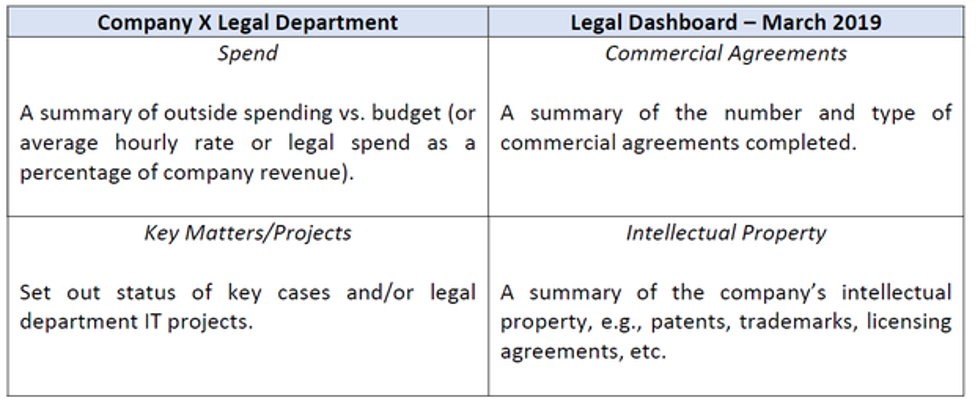If you have ever run an in-house legal department, or just been part of one, you know that one constant question is, "how are we doing?" While it appears to be a simple question, it is fraught with multiple meanings. It could mean how are we doing against the budget? How are we doing with turning contracts for the business? How are we doing in the litigation? Or, how are we doing with our compliance efforts? Regardless of the "what," the "how" has troubled legal departments for decades. That's because historically the legal department lacked the data to measure whatever question was being asked. Consequently, the legal department was often excused from performing or reporting with the same discipline and reliability as other parts of the business. Legal was special. Legal was excused. But, not anymore. Businesses of all sizes increasingly expect their legal departments to work with — and report out — data the same way as the rest of the company. That is why the use of data analytics is now a priority for in-house lawyers. This edition of "Ten Things" will discuss the basics of using data analytics in your legal department:

These are just examples. Your dashboard depends entirely on what information is important to you, the department, and the C-Suite. And if you want to get creative, programs like Tableau can turn plain data into awesome visuals.
Using data analytics in legal departments is a no-brainer. Not only will you begin to get deep insights into the operations of the department, but you will also be able to provide better advice to the business-backed up by data and not just gut instinct. Start small and simple, then work your way up to more complicated questions. Ultimately, your analysis will start to drive excellence, efficiency, and better decisions ' by the department and the business.
1. What is data analytics?
Data analytics is the process of creating, categorizing, and examining data sets in order to draw inferences and conclusions from them. In other words, "what does this data tell me?" The users then use the data and conclusions to make better, more informed decisions or to increase operational efficiency. For in-house legal departments, this cuts across a wide variety of issues, from budgets and spending to litigation outcomes.2. Why is it important?
Simply put, the need for in-house legal departments to adopt and use data analytics has never been more urgent. If you consider that many legal decisions in the past were often made by hunches or guesses, and that law firm relationships were usually based on who went to law school with the general counsel, you can instantly see the appeal — and importance — of using data analytics to make (and track) those same decisions. Visibility and insight create actionable intelligence. If you couple that with better decisions and the now glaring need for legal departments to operate and report just like any other business function, the increasing demand by in-house lawyers for better data and better tools to analyze that data is hardly a surprise. Underlying this importance is a fundamental truth all in-house lawyers need to understand — the language of business is numbers. If you are not talking to the business with numbers — accurate numbers at that — then you might as well be speaking in a foreign language. The use of data analytics allows you to talk the talk. The business is far better able to comprehend legal issues that can be discussed as numbers, e.g., a decision tree, than they are if you are babbling on about a footnote written by a dissenting judge. Likewise, if you are able to show — with math – that the legal department handled 10% more contracts with the same number of staff you are on your way to being left alone. By left alone I mean legal departments that demonstrate they are operating like a business get a long leash from the business vs. those that are constantly over-budget or asking for more staff.3. How do you start?
The core of data analytics is data. So, you start with identifying all of the data available to your legal department. This should come naturally to most in-house lawyers because it is part and parcel to what we do every day — gather evidence so we can analyze it and draw out our legal conclusions. Data analytics is essentially the same thing: Find the data and use it to make conclusions. Consequently, locate every piece of data you can find that touches or is touched by the legal department. Here are some places to start:- eBilling systems (and if you are not using an eBilling system, gathering data directly from invoices by hand or asking your law firms and vendors to provide it).
- Matter management systems (electronic or manually maintained).
- Reports generated by the legal department itself.
- Data available from legal-related tools utilized by the legal department, e.g., Thomson Reuters, Lexis-Nexis, Gartner/CEB, and so forth.
- Data generated/created by other departments at the company, such as Finance, Marketing, IT, Compliance, HR, etc.
- Publicly available data (free or purchased, e.g. benchmarking data).
- Government data.
4. What do you want to measure?
Once you understand your data sources, your next challenge is determining what you want to measure. The "what" is the fundamental purpose behind data analytics. Coming up with the "what" may be hard or easy, depending on how your legal department operates. Think about the data you have. Next, think about questions where the answers could make the department run more effectively and/or efficiently, or reduce risk to the company. The process goes something like this:- What do you want to measure and why?
- Locate and obtain the relevant data.
- If necessary, clean and structure the data.
- Run the analysis.
- Draw your conclusion/make decisions based on results.
5. Common measurements?
The ways in-house lawyers can utilize data analytics are virtually endless. The only limit is the data you have on hand and your ability to imagine uses and questions. In my experience, here are some of the most common things that legal departments seek to measure using data analytics:- Spending efficiency or effectiveness.
- Efficiency of outside counsel.
- Structuring the legal budget.
- Workload distribution in the department.
- Turn-around time by the department.
- Contract analysis (e.g., which clauses are the most negotiated?).
- Litigation outcome analysis (e.g., when to settle and for how much?).
- Compliance (e.g., predicting compliance problems based on searching company data).
- E-Discovery costs and effectiveness.
- Legal analysis (review of contracts, legal strategies, opponent's briefs, etc.)
- Department process improvements.
- Measuring attainment of department goals or KPIs.
- Benchmarking — how does your department stack up?
- Whatever the C-Suite wants you to measure.
- Ask your outside counsel to create analytics specific to the matter(s) they are handling for you.
6. The role of "Artificial Intelligence" in data analytics.
It is no surprise that data analytics and artificial intelligence go hand-in-hand. While you do not need AI to perform analytics, if the data sets are large, using AI can help make the task manageable. AI is good for finding patterns in large data sets. For example, if you wanted to review a few years' worth of outside counsel bills to look for entries that are of low value or indicate a "heavy pen," AI can do that task in minutes. Likewise, if you want to know if the data held by the company (emails, financial accounts, Slack messages, etc.) reveals any indications of FCPA/anti-bribery law violations so you can nip them in the bud, AI can do that task — one that humans simply do not have the time to complete. Or, if you wanted to find the outcomes of all the cases tried in US courts that have a similar fact pattern to yours, AI is the answer. The future of legal department data analytics is AI, so it's time to start figuring out how you can get on board this fast-moving train before it leaves you and your bags at the platform.7. The role of legal operations in data analytics.
First, if your department is bigger than a handful of lawyers you need to seriously think about hiring a legal operations manager (something I will be writing about soon). The other parts of the business have operations people, why not the legal department? If Legal is expected to run like the rest of the business, then you cannot have the General Counsel or other highly valuable lawyers or staff crunching spreadsheets and tracking down data. If you have a legal operations person or team, data analytics is the perfect task to assign them. But, it's more than just getting work out of the hands of the lawyers. Professional legal operations people are trained/experienced in the access, use, and manipulation of data sets (along with many other valuable skills). Why not let the professionals run the process, while you get to ask the questions and draw the conclusions from the data? If you do not have an operations person and it's unlikely you will get one, then you must simply do the best you can either by yourself or by bringing in others on your team to help out — or, if possible, hiring someone on a temp basis to come in and help you get set up.8. Dashboards.
One of the cool benefits of using data analytics in a legal department is that you can start to generate data/results that you can use in a dashboard. Dashboards are a commonly used tool by businesses to give a visual summary of the status of a project, a goal (or goals), spending, IT systems, or pretty much whatever you would like to show visually. Many in-house lawyers sit in meetings where various groups roll out super-slick, highly-visual dashboards that allow them to discuss key points in easily digestible snippets revealed via the dashboard. So far, most in-house lawyers are missing out on this trend. As you start to get your arms around your data and start to ask and answer questions around how the department is operating (vs. goals or vs. benchmarks), you can capture those answers in a dashboard. It may be that the dashboard is only for use within the department at staff meetings, or it may become something you have with you whenever there is a cross-functional meeting where groups are reporting out on "how they're doing." A basic dashboard for the legal department might include four boxes on a slide:
These are just examples. Your dashboard depends entirely on what information is important to you, the department, and the C-Suite. And if you want to get creative, programs like Tableau can turn plain data into awesome visuals.
9. Go for quick wins.
It bears repeating that the smart play for those starting out with legal department data analytics is to go slow and find the low hanging fruit. Jumping into the deep end without learning to swim first, will probably mean a lot of wasted time and money. And no in-house lawyer has time or money to spare. Start with the data you have on hand now, come up with some simple questions to measure, and get into a rhythm of generating simple, helpful reports. Share the results with the department so they can see the good and the bad. For example, if your average hourly rate for outside counsel is way out of whack, your team can help manage that number down through their engagement with outside counsel. Transparency is good for any in-house legal department, even if it hurts. Don't feel pressured to share the data outside of the legal department right away — unless someone has asked for it. Spend time refining your processes and making sure you understand the results and if things are not where you want them to be that you have a plan to fix it. Showing up with a "problem" and without a plan to solve it means a long, painful meeting. As you gain experience and as you figure out different data sources or different questions to ask, you can start to expand your use of data analytics, with the goal always being how can you use this data to make the legal department operate better and keep the company out of trouble.10. Where can I learn more?
Good sources of data analytics best practices are starting to emerge. Here are a few places to go for more information and resources:- Corporate Legal Operations Consortium (CLOC) — one of the two main bodies for legal operations professionals. Data analytics is a core competency for its members.
- ACC Legal Operations — the ACC Legal Operations section is the other main group for operations professionals. In addition, like all ACC groups, it offers tool kits, benchmarking, and other benefits. It also offers an operations maturity model with a specific component dedicated to metrics and analytics.
- Strategic Legal Technology Blog — a great blog for lawyers interested in technology. It includes a number of posts on data analytics.
- Your company — if you have seen others in your company use data analytics, invite them to lunch and pick their brain (especially if the is a data analytics group already established). See what they know about data sources, tools to analyze data, creating reports, or whatever. Sometimes the best resources are right under our noses and cost us nothing but the time to ask for help.
Using data analytics in legal departments is a no-brainer. Not only will you begin to get deep insights into the operations of the department, but you will also be able to provide better advice to the business-backed up by data and not just gut instinct. Start small and simple, then work your way up to more complicated questions. Ultimately, your analysis will start to drive excellence, efficiency, and better decisions ' by the department and the business.





